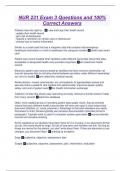NUR 231 Exam 3 Questions and 100%
Correct Answers
Patients have the right to... ✅- see and copy their health record
- update their health record
- get a list of disclosures
- request a restriction on certain uses or disclosures
- choose how to receive information
Similar to a credit card that has a magnetic strip that contains vital emergency
healthcare information or a link to healthcare info using pin number ✅health care smart
card
Patient care record created when facilities under different ownership share their data;
accessible to designated health care providers anywhere ✅ehr (electronic health
record)
Electronic patient care record created by facilities that have common ownership; not
true ehr because data is not being shared between providers under different ownerships
(ex: all of iu health) ✅emr (electronic medical record)
Allows doctors, nurses, pharmacists, etc, and patients, to appropriately access and
securely share a patient's vital medical info electronically; improves speed, quality,
safety, and cost of patient care ✅hie (health information exchange)
Collection of data that allows easy searching and easy retrieval of similar pieces of data
from many records ✅electronic database
Older, more traditional way of recording patient data (paper chart). Source oriented
means that each different health care provider will have own spot in chart where they
document (dietitian, pt, nurse, physician.) Advantage is that each discipline can easily
find where to chart. Nurses typically use narrative documentation (storylike format in
paragraph). Typically what is used if a computer system goes down ✅source-oriented
records and narrative charting
Some residents at our facilities have been there for 5 or 6 years, if you document all that
you do, the charts would be huge. So lots of long term care facilities use this. As long as
things are normal for the patient, you don't write about them. If they are abnormal or any
changes, you document them. ✅charting by exception
Soap ✅subjective, objective, assessment, plan
Soapie ✅subjective, objective, assessment, plan, intervention, evaluation
, Soapier ✅subjective, objective, assessment, plan, intervention, evaluation, response
Pie charting ✅problem, intervention, evaluation
Focus charting (dar) ✅data, action, response
Used to document any event that is not consistent with the routine operation of a health
care unit or the routine care of a patient ✅incident or occurrence reports
Sbar ✅situation, background, assessment, recommendation
•a planned method or series of methods used to help someone learn. The concept of
imparting knowledge through a series of directed activities. ✅teaching
•the process by which a person acquires or increases knowledge or changes behavior
in a measurable way as a result of the experience. ✅learning
Steps of the teaching-learning process ✅- assess learning needs and learning
readiness
- diagnose the patient's learning needs
- develop a teaching plan
- implement teach plan and strategies
- evaluate learning
Addresses the patient's desire or willingness to learn ✅motivation to learn
Depends on physical and cognitive abilities, developmental level, physical wellness,
though processes ✅ability to learn
Allows a person to attend instruction ✅learning environment
Knowles four assumptions about adult learners ✅1.as a person matures, one's self-
concept is likely to move from dependence to independence.
2.the previous experience of the adult is a rich resource for learning.
3.an adult's readiness to learn is often related to a developmental task or a social role.
4.most adults' orientation to learning is that material should be useful immediately,
rather than at some time in the future.
Strategies for adult learners ✅•identify learning barriers.
•allow extra time.
•plan short teaching sessions.
•accommodate for sensory deficits.
•reduce environmental distractions.




